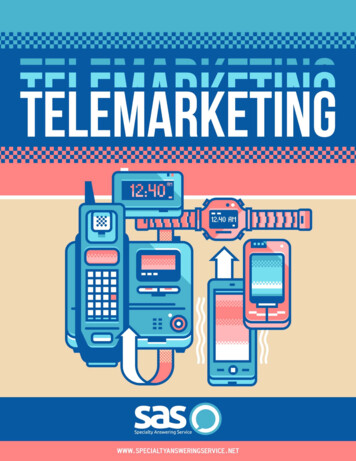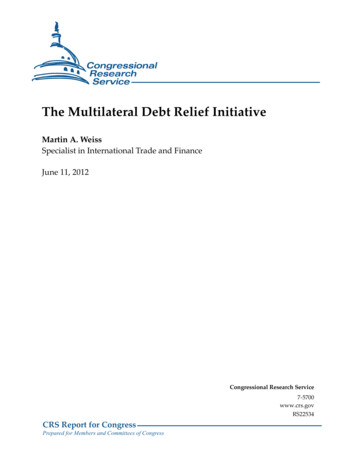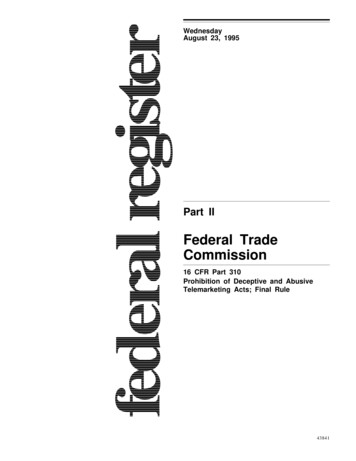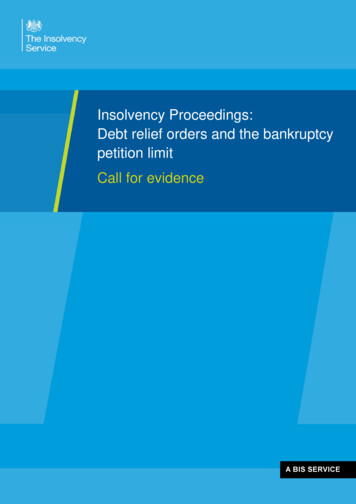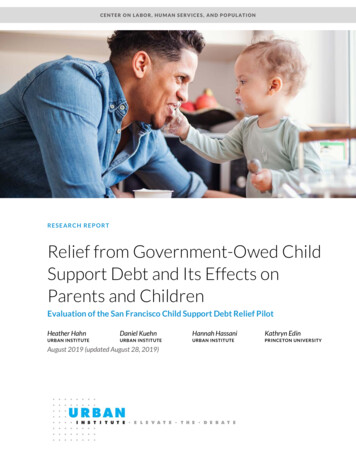
Transcription
DEBT RELIEFSERVICES & THETELEMARKETINGSALES RULE:A Guide for BusinessFederal Trade Commission ftc.gov
Many Americans struggle to pay their credit card bills. Someturn to businesses offering “debt relief services” – for-profitcompanies that say they can renegotiate what consumers oweor get their interest rates reduced.The Federal Trade Commission (FTC), the nation’s consumerprotection agency, has amended the Telemarketing Sales Rule(TSR) to add specific provisions to curb deceptive and abusivepractices associated with debt relief services. One key changeis that many more businesses will now be subject to the TSR.Debt relief companies that use telemarketing to contact potential customers or hire someone to call people on their behalfhave always been covered by the TSR. The new Rule expandsthe scope to cover not only outbound calls – calls you place topotential customers – but in-bound calls as well – calls theyplace to you in response to advertisements and other solicitations. If your business is involved in debt relief services, hereare three key principles of the new Rule: It’s illegal to charge upfront fees. You can’t collect anyfees from a customer before you have settled or otherwise resolved the consumer’s debts. If you renegotiatea customer’s debts one after the other, you can collecta fee for each debt you’ve renegotiated, but you can’tfront-load payments. You can require customers to setaside money in a dedicated account for your fees and forpayments to creditors and debt collectors, but the newRule places restrictions on those accounts to make surecustomers are protected. You have to disclose certain information beforesigning people up for your services. Before peoplesign up, you must disclose fundamental aspects of yourservices, including how long it will take for them to getresults, how much it will cost, the negative consequencesthat could result from using debt relief services, and keyinformation about dedicated accounts, if you use them.1
You can’t misrepresent your services. The new Ruleprohibits you from making false or unsubstantiatedclaims about your services.Is your business covered by the new Rule? Are you certain ofyour legal obligations? This Guide tells you how to complywith the new Rule and is designed to supplement the FTC’spublication, Complying with the Telemarketing Sales Rule. TheGuide represents the views of FTC staff and is not binding onthe Commission.WHO'S COVERED BY THE NEW RULEThe new Rule applies to for-profit sellers of debt relief servicesand telemarketers for debt relief companies. The new Ruledefines a “debt relief service” as a program that claims directly,or implies, that it can renegotiate, settle, or in some way changethe terms of a person’s debt to an unsecured creditor or debtcollector. That includes reducing the balance, interest rates orfees a person owes. The TSR defines “telemarketing” as a “plan,program, or campaign . . . to induce the purchase of goods orservices” involving more than one interstate telephone call.Most of the provisions of the TSR apply to sellers and telemarketers, so the terms “company” and “provider” in this Guiderefer to both. In addition, certain parts of the Rule apply tothose who provide substantial assistance or support to sellersor telemarketers.Some examples of debt relief services include: Debt settlement – Companies that say they can settlecustomers’ debts for less than the full balance.Example 1: Company A advertises a program to helppeople settle their credit card debts for less than what theyowe. It requires customers to set aside monthly payments2as savings. Company A waits until there is enough moneyin the account to make an offer to the creditor or debt collector. It negotiates an offer from the creditor or debt collector to settle the debt and gets the customer’s approval.The customer pays the reduced amount to settle the debt.Company A is covered by the new Rule.I operate a non-profit organization. Does the new Ruleapply to us?Bona fide non-profit organizations aren’t covered becausethe TSR applies only to for-profit companies. However, theRule covers companies that falsely claim nonprofit status. Debt negotiation – Companies that say they can reducetheir customers’ monthly payments by getting creditors toreduce interest rates or agree to other concessions.Example 2: Company B says it can reduce customers’credit card debt or monthly payments by negotiating withcredit card companies to get a lower interest rate. Aftera person signs up for the program, Company B calls thecredit card company – sometimes with the customer onthe line – and asks for concessions. Company B is coveredby the new Rule.Example 3: Company C says it can reduce customers’credit card debt or monthly payments by negotiating withcredit card companies to get a lower interest rate. Whenpeople sign up for the program, Company C gives them apayment schedule with accelerated payments, claiming it3
only promised to “show” customers how they could savemoney. Company C is covered by the new Rule. helping a debt relief company with its back-room operations, for example, by reviewing customer files, processing customers’ payments or contacting customers’ creditors once they’ve signed up; or offering dedicated accounts to customers where they setaside the debt relief provider’s fees and funds for payments to creditors or debt collectors (more about that onpage 16). Credit counseling – Companies that work as a liaisonbetween customers and their creditors to negotiate andadminister a monthly payment plan (often called a “debtmanagement plan”) that makes it more manageable fora customer to repay the debt – for example, by loweringinterest rates or forgiving late feesExample 4: Company D says it can consolidate customers’ multiple credit card payments into a lower singlemonthly payment. When a person signs up for theprogram, Company D works with creditors and securesan agreement to a debt management plan on behalf ofthe customer. As part of that plan, the customer agrees tomake monthly payments to each creditor, and the creditors agree to reduce the customer’s interest rates or makeother concessions so that the payment is more manageable.Company D administers the customer’s monthly payments. The customer sends the payment to Company D,which then sends the payments to each of the customer’scredit card companies. Company D is covered by the newRule.Even if you don’t directly sell or provide debt relief services, youmay have obligations under the new Rule. Specifically, it’sillegal to provide “substantial assistance” to another company ifyou know they’re violating the Rule or if you remain deliberately ignorant of their actions. What amounts to substantialassistance depends on the facts. In the context of debt reliefservices, substantial assistance may include: 4obtaining and selling leads – the contact information ofpotential customers – to other companies;If you work with debt relief companies, review their policies,procedures and operations to make sure they’re complying withthe Rule. Willful ignorance isn’t a defense.I'm an attorney and I provide debt relief services. Am Icovered by the new Rule?There’s no general exemption from the TSR for attorneyswho engage in telemarketing. However, most attorneys arelikely to fall outside the Rule for at least two reasons. First,the TSR applies only to providers who use interstate telemarketing. Second, providers – including attorneys – whomeet face-to-face with their customers before signing themup are likely exempt from most of the Rule’s provisions.Read Complying with the Telemarketing Sales Rule to see ifthe face-to-face exemption applies to you.TYPES OF TELEMARKETING CALLS COVEREDBY THE NEW RULEThe Telemarketing Sales Rule has covered a wide variety oftelemarketing transactions since it was enacted in 1995, including the sale of credit repair services, products with a negativeoption feature, prize promotions and advance fee loans. Debt5
relief companies that initiate calls to potential customers orhire others to call people for them have always been coveredby the TSR. The new Rule expands the scope of the TSR tocover many debt relief services in-bound calls (calls potentialcustomers place to you or someone working on your behalf ),in addition to outbound calls (calls you or someone who worksfor you place to potential customers). Here are some examplesof the kinds of calls covered by the new Rule: Calls to you in response to advertising – consumer callsin response to TV or radio commercials; infomercials;home shopping programs; ads in magazines, newspapersor the phone book; online ads; billboards; or ads in othermedia . Calls to you in response to most direct mail promotions– consumer calls in response to postcards, flyers, doorhangers, brochures, “certificates,” letters, email, faxes, etc.,urging people to call about debt relief services.Example 5: Company E runs ads on TV, radio, websitesand billboards to market its program to settle consumers’ credit card debt for less than what they owe. The adsfeature a number to call for more information. The newRule covers those calls and any transactions resulting fromthem.Example 6: Company F mails a letter saying it can getpeople lower interest rates from their credit card companies. The letter encourages recipients to call to learn moreabout the service. The new Rule covers those calls and anytransactions resulting from them.Companies selling debt relief services and people working ontheir behalf are subject to all of the existing restrictions of theTSR – including, for example, the Do Not Call provisions of6the Rule. Additionally, all of the existing exemptions from theTSR apply. For example, businesses – including debt reliefservice companies – that meet with their customers face-toface before signing them up for their services are exempt fromthe TSR. Read Complying with the Telemarketing Sales Ruleto find out more.My company helps customers settle debts that aren’t necessarily credit card debts. Does the new Rule apply to us?The definition of “debt relief service” covers all types ofunsecured debts. If the other debts you settle are unsecured– for example, medical debts – you’re covered by the newRule. Services promising relief from mortgage debt are notcovered under the TSR. They’re the subject of a separateFTC Rulemaking on Mortgage Assistance Relief Services(MARS). Visit www.ftc.gov.INFORMATION YOU MUST DISCLOSETO CUSTOMERSIf you provide debt relief services, the new Rule lays out severalkey pieces of information you must disclose both truthfully andclearly and conspicuously – either orally or in writing – beforepeople sign up for your services. The “clear and conspicuous”standard means that information must be presented in a waythat average consumers would notice and understand. Buryingrequired disclosures in a lengthy fine-print contract, disclosing them in a hard-to-read block of text, or including them ina rapid-fire oral presentation isn’t sufficient to meet the standard. The Rule isn’t specific about type sizes, and it gives someflexibility on how to convey the information, but it’s very clearthat you must communicate certain disclosures as effectively as7
you communicate your sales message. Read Complying withthe Telemarketing Sales Rule for more on how to make yourdisclosures clear and conspicuous.Under the existing disclosure requirements of the TSR –which now apply to your in-bound calls – and a new provision of the Rule, you must disclose key facts to consumers,including:1. How much your service costs and other importantterms. Before someone signs up for your service, youmust disclose all fees. If you charge a specific dollaramount, you must disclose that amount. If you chargea percentage of the amount a customer would save as aresult of your program, you have to disclose both the percentage and the estimated dollar amount it represents forthat customer. In addition, before someone signs up, youmust disclose any material restrictions, limitations, or conditions on your services. If the sales presentation includesa statement about your company’s refund policy, you mustalso include a clear and conspicuous disclosure of all termsand conditions of the policy. If you don’t give refunds, theRule requires you to tell people that before they sign upfor your service.Example 7: A debt settlement company, Company G,charges a service fee of 10% of any debt reduction it getsfor its customers. Adam signs up for the program with asingle credit card debt of 5,000. Based on its experiencewith that credit card company, Company G estimates itcan settle Adam’s debt for 3,000 – a reduction of 2,000.Under the new Rule, before Adam signs up for the program, Company G must disclose that it will charge him10% of the amount of debt reduction, or an estimated 200 (10% of 2,000).82. How long it will take to get the advertised results. Youmust tell your customers how long it will take for them toget the results you represent. For example, if your serviceincludes debt settlement, you must give a good faith estimate of how many months or years the customer will haveto wait before you’ll make an offer to each creditor that’slikely to result in a settlement. You have to have a reasonable basis for any statements you make – for example, youcan base your estimates on your experience with previouscustomers. Be precise: If you have experience with certaincreditors, your estimate must reflect that experience. Yourestimate should take into account the circumstances ofeach customer, and the results achieved by customers insimilar circumstances.3. How much money a customer must save before you’llmake a settlement offer to creditors. You must tellpotential customers how much money or what percentage of each outstanding debt they must accumulate beforeyou’ll make an offer to each creditor that’s likely to resultin a settlement. If you’re estimating, you must have a reasonable basis for your estimate. For example, if someoneowes 10,000 to a creditor and your data shows that thiscreditor is likely to settle the debt for 6,000, you musttell the potential customer before he or she signs for yourprogram that he or she will have to save about 6,000 tosettle the debt.4. The consequences if the customer fails to make timelypayments. If you ask your customers to stop makingtimely payments to their creditors – or if your programrelies on that practice – you must tell them about the possible consequences of doing so, including: damage to their credit report and credit score; that creditors may sue them or continue with thecollections process; and9
that they may accrue new fees and interest, whichwill increase the amount they owe.5. The customer’s rights regarding dedicated accounts. Ifyou ask or require your customers to set aside funds, firstyou must make sure the funds are in an account at aninsured financial institution. Next, you must disclose that:the amount of money or the percentage of each outstanding debt the customer must accumulate beforeyou’ll make a bona fide offer to negotiate, settle, ormodify the terms with creditors; the effect of your service on the customer’screditworthiness; the customer owns the funds held in the account; the customer may withdraw from your service at anytime without penalty; andthe effect of your service on the collection efforts of anycreditors or debt collectors; the percentage or number of customers who have gottenthe results you represent; and whether your business is a bona fide nonprofit entity. if the customer decides to withdraw from yourservice, he or she will get back all the money in theaccount other than fees you earned in compliancewith the TSR.MAKING TRUTHFUL AND SUBSTANTIATEDCLAIMSIf you provide debt relief services, it’s illegal to misrepresent anymaterial aspect of your services, either explicitly or by implication. A material aspect of a debt relief service includes anyinformation that is likely to affect someone’s decision to signup for your program or to choose one program over another.Some examples of claims that would be material:10 the amount of money or the percentage of the debtsomeone may save by using your service; the amount of time necessary to get the results yourepresent; the amount of money or the percentage of each outstanding debt the customer must accumulate beforeyou’ll begin your attempts to negotiate, settle, or modifythe terms with creditors;May I base my advertising claims on the experiences ofsome previous customers?Yes, but your sample must be representative of the entirerelevant population of your past customers. To accomplishthis you must, among other things, use appropriate samplingtechniques, proper statistical analysis, and safeguards forreducing bias and random error. You can’t cherry-pick themost successful examples to inflate your results.If you advertise or represent that your customers will save acertain amount of money or reduce their debt by a certainpercentage – for example, “We can settle your debts for 40% to60%” – your statements must be truthful, and you must haveobjective proof to back them up. Your claims must accuratelyreflect the results you’ve achieved for previous customers. It’simportant to consider the message your claims convey. Underthe law, the FTC looks at claims from the point of view ofreasonable consumers. Therefore, what matters isn’t the literalaccuracy of the words you use, but rather your proof to support11
the “net impression” your message conveys. For example, claiming that your past customers have achieved “up to 60% savings”is likely to convey to new customers that they, too, will get savings of around 60%. If you don’t have solid proof to back thatup, the claim is deceptive.Here are several important requirements for making sure yoursavings claims are truthful and not deceptive:1. State the savings based on the customer’s debt when heor she signs up for the program. You may not inflate savings figures or percentages by including interest and feesthe credit card company adds after a customer signs up foryour program.Example 8: Andy signs up with a debt relief serviceoffered by Company H, owing 10,000 on his credit card.One year later, following negotiations with the credit cardcompany, Company H negotiates a settlement allowingAndy to pay 6,000 to resolve the debt. However, sinceAndy enrolled, the credit card company has chargedhim interest and late fees totaling 2,000, so that Andynow owes 12,000. By getting a settlement for 6,000,Company H has saved Andy 4,000 ( 10,000 minus 6,000) or 40% of the debt at the time of enrollment. Itwould be deceptive for Company H to claim to have savedAndy 6,000 ( 12,000 minus 6,000) or 50% of his debt.12deceptive for Company J to claim to have saved Betty 5,000 – or 50% of her debt – because Betty also had topay 1,000 in fees. Instead, Company J may truthfullystate Betty’s savings as 4,000 ( 5,000 minus 1,000) or40% of Betty’s debt.3. In calculating the results you’ve achieved over time, youmust include customers who dropped out or otherwisefailed to complete the program. Don’t base your savingsclaims only on customers who successfully completed yourprogram.Example 10: Company K had 10 customers signed upfor its service. Each one had 10,000 in unpaid creditcard debt for a total of 100,000. Five of the customers completed the program, and each saved 5,000 – fora total savings of 25,000. The remaining five customers dropped out of the program, each one still owing the 10,000 they owed when they signed up with the program. Taken together, Company K has saved its customers 25,000 – or 25% – of the total 100,000 debt theyhad when they signed up with the program. It would bedeceptive for Company K to exclude the drop-outs andclaim that it saved its customers 50% of their debt.2. Include the impact of your fees on the claimed savings.You may not inflate your savings claims by excluding thefees your customers paid you.4. Include all debts enrolled by your customers, not onlythose that have been settled successfully. In calculating your savings claim, you may not exclude accounts youfailed to settle, even if the failure was due to customersdropping out of your service.Example 9: Betty owes 10,000 on her credit card, andsigns up with Company J’s debt relief service. Company Jgets a settlement allowing Betty to pay 5,000 to resolvethe debt. However, at the time of settlement, CompanyJ charges Betty a 1,000 fee for its work. It would beExample 11: Company L has 10 customers, and each ofthem enrolls two 1,000 debts in the program – totaling 20 debts or 20,000. Company L is able to settle 10of the 20 debts, each for 500. However, it was unableto settle the remaining 10 debts before those customers13
either completed or dropped out of the program. Thus,Company L has saved its 10 customers 5,000 or 25%of their debts in the program. It would be deceptive forCompany L to exclude the 10 accounts that weren’t settledand claim a savings rate of 50%.COLLECTING FEESIf you provide debt relief services, the new Rule says you can’tcollect any fee from a customer until you meet these threerequirements:1. You must have reached a successful result for yourcustomer. You must have renegotiated, settled, reduced,or otherwise changed the terms of at least one of the customer’s debts.2. There must be an agreement between your customerand the creditor. Your customer must agree to the settlement agreement, debt management plan, or other resultreached with the creditor due to your service. Accordingto the Rule, the agreement from the creditor must be inwriting, although your customer may agree to it orally.You can’t take your fee in advance by getting your customer to agree to a blanket “pre-approval” of any settlement you might be able to negotiate in the future.3. Your customer must have made a payment to the creditor. Your customer must have made at least one paymentto the creditor or debt collector as a result of the agreement you negotiated.It is illegal to front-load your fees. If your customer has multiple debts enrolled in your program and you’ve settled one ofthem, you may collect a portion of your full fee – as long as youalso have completed the three required steps in connection with14that debt. The new Rule gives you two options for calculatingyour fee if your customer has enrolled multiple debts: Alternative 1:Proportional fee. According to the Rule,your fee must “bear[] the same proportional relationshipto the total fee for renegotiating, settling, reducing, oraltering the terms of the entire debt balance as the individual debt amount bears to the entire debt amount.” The“individual debt amount” and the “entire debt amount”refer to what your customer owed at the time her or sheenrolled the debt in the service. So if you settle a proportion of a customer’s total debt enrolled with you, you mayget that same proportion of your total fee.Example 12: Company M enters a contract with Alex tosettle his debts. When Alex enrolls, he owes three separate 1,000 debts in the program for a total of 3,000.The contract states that Company M will charge Alex atotal fee of 600. Six months after Alex enters the program, Company M settles one of his debts. Alex signsan agreement with the creditor and pays the settlementamount. In this example, Company M now may chargeAlex a 200 fee – one-third of its total fee – because thecompany settled one-third of his total debt. Alternative 2:Percentage of Savings. If you base yourfee on a percentage of what your customer saved as a resultof your service (often called a contingency fee), the percentage you charge must be the same for each of a customer’s debts. Further, the amount saved must be basedon the difference between the amount of debt enrolled inthe program and the amount of money required to satisfythe debt.Example 13: Company N enters a contract with Barbarato settle her debts. She enrolls three separate 1,000 debts15
in the program for a total of 3,000. Company N clearlyand conspicuously discloses to Barbara that its fee willbe 25% of the savings achieved by using its service. Sixmonths after entering the program, Company N settlesone of Barbara’s debts for 600 – saving her 400 of the 1,000 she owed on that account. Barbara signs an agreement with the creditor and pays the settlement amount.Company N may collect a fee of 100 – 25% of the 400Barbara saved.REQUIRING A DEDICATED ACCOUNTUnder the new Rule, you may require your customers to setaside your fee and funds to pay debts in a dedicated account aslong as: the account is held at an insured financial institution; the customer owns the funds (including any interestaccrued), controls them, and can withdraw them at anytime; you don’t own or control the company administering theaccount or have any affiliation with it; you don’t split fees with the company administering theaccount; and 16the customer can stop working with you at any timewithout penalty. If the customer decides to end therelationship with you, you must return the money inthe account to the customer within seven business days(minus any fees you’ve earned from the account in compliance with the TSR).The independent company that administers the account maycharge the customer a reasonable fee, but it may not transferany of the customer’s funds to you – directly or indirectly– until you have renegotiated, settled, reduced, or otherwisechanged the terms of at least one of your customer’s debts andmet all the related requirements in the Rule.It’s illegal to provide “substantial assistance” to another company if you know they’re violating the Rule or if you remaindeliberately ignorant of their actions. To avoid liability forfacilitating violations of the new Rule, companies that administer dedicated accounts should review the policies, procedures,and operations of the debt relief providers to ensure they’recomplying with the advance fee ban provision of the Rule,including the provision relating to dedicated accounts. As theycontinue to administer dedicated accounts, companies alsoshould investigate consumer complaints and disputed payments. Some companies administering dedicated accounts maynot be subject to the FTC’s jurisdiction, but laws enforced byother government agencies may apply to them.KEEPING RECORDSUnder the new Rule, any debt settlement, debt managementplan or other debt resolution plan from a creditor must be inwriting. You must keep these documents for at least two years.The type of documentation depends on the services you provide. Examples of acceptable documentation include: For credit counseling – a debt management plan contain-ing the new terms binding on all applicable creditors anddebt collectors, with evidence that the customer has madethe first payment. For debt settlement – a letter or receipt from the creditoror debt collector stating that the debt has been satisfiedand the amount of the payment received, or other documentation that contains a specific settlement offer fromthe creditor or debt collector and evidence of a corresponding payment to the creditor or debt collector.17
For debt negotiation – a written document from a credi-type of service you offer and the results you promise. Thebottom line is that you should have good reason to believethat the people you sign up are capable of making thepayments associated with your program and are likely tocomplete it successfully, based on their situation when theysign up with you. Train and supervise your employees tomake sure they’re following your procedures. Particularlyif you pay your sales staff a commission based on howmany people they sign up for your program, monitor themcarefully to make sure they don’t misrepresent the serviceto potential customers. Review and update your procedures periodically.tor or debt collector stating that it has agreed to a concession – for example, a lower interest rate for a credit card– with evidence that the customer has made at least onepayment under the new terms.You have to retain documentation of all fees you collected fromeach customer. It’s a good practice to give them copies of allpaperwork as well.Savvy businesses know that it’s best to get a customer’s written approval for all debt settlements. The new Rule recognizesthere might be an exceptional case when a customer’s oralagreement will have to suffice – for example, if a creditor offersa very favorable settlement available only for a limited time.But oral agreements should rarely be used. Indeed, membersof the debt settlement industry should be careful not to pressure customers to act without taking time to think over theirdecision. Keep in mind that it’s risky to rely solely on oralcommunications. If you get a customer’s oral agreement, it’swise to write a note to that effect, keep it on file with the creditor’s written agreement, and follow up in writing with yourcustomer.BEST PRACTICESIn addition to adhering to the basic compliance requirementsof the new Rule, providers of debt relief services may want toincorporate other practices to help their customers: Screen prospective customers for suitability.Debt reliefprograms aren’t right for everyone. For example, somepeople may have so many debts and so few assets that filing for bankruptcy is their best option. Set up reasonablewritten procedures to ensure that each customer is suitablefor your program. What’s reasonable may depend on the18 Keep your customers in the loop.Update your customers on the status of your negotiations and progress– including any important communications from theircreditors. Tell them about any changes in their creditors’policies that may affect how long the process will take orhow much money it will take to settle their debts. Let customers communicate with creditors. You shouldallow your customers to contact – and be contacted by –their creditors. Tell customers abou
The Telemarketing Sales Rule has covered a wide variety of telemarketing transactions since it was enacted in 1995, includ-ing the sale of credit repair services, products with a negative option feature, prize promotions and advance fee loans. Debt only promised to "show" customers how they could save money. Company C is covered by the new .


